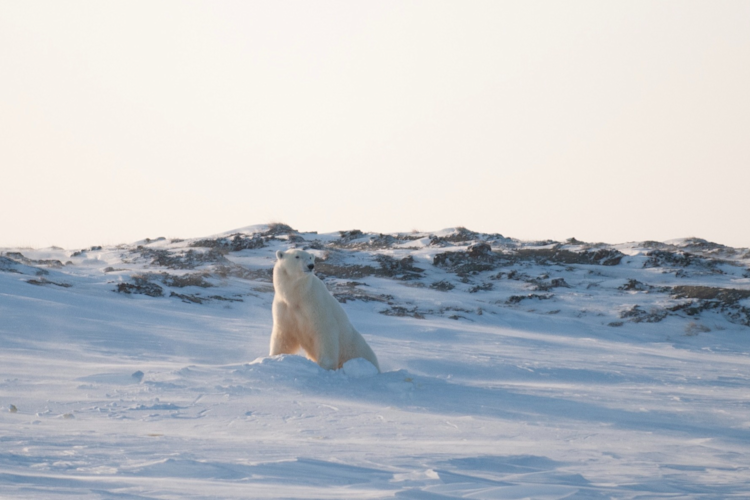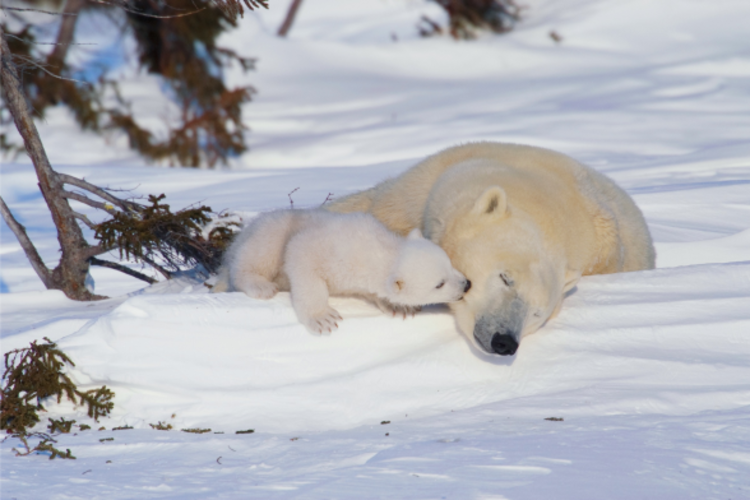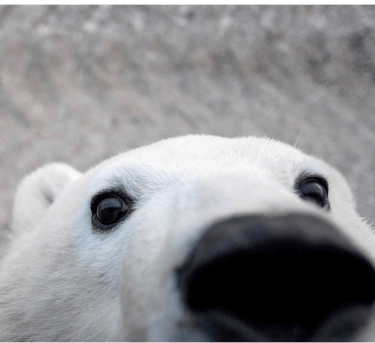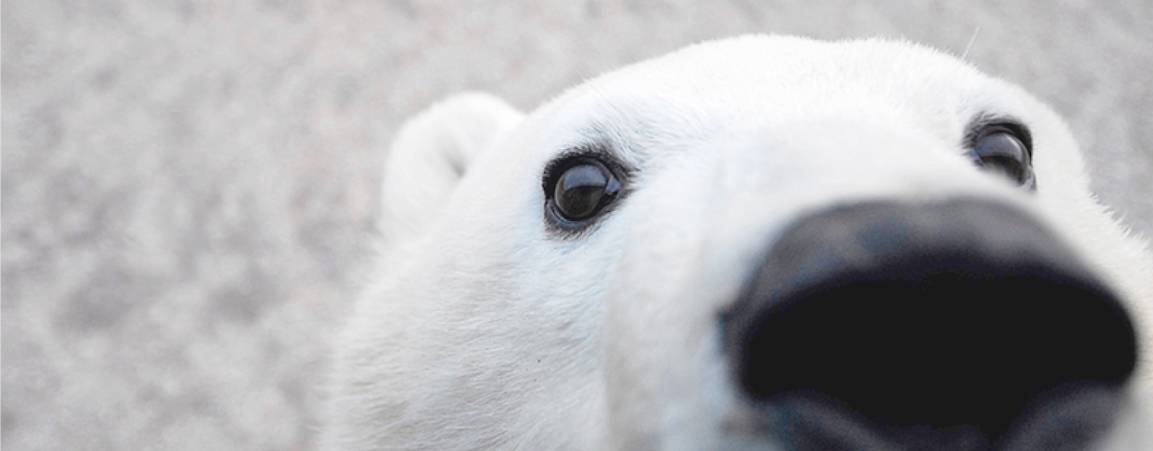Each year, the Polar Bears International Bear Tracker follows a subset of GPS-collared female polar bears in Hudson Bay. By monitoring movement data, scientists learn more about when and how polar bears use their sea ice home, helping us better understand what the species needs to survive and thrive.
Summer is the time of year when polar bears are wrapping up their biggest feasting period — a time when they gorge themselves on the bounty of plump seal pups. It’s also their mating season. They should be fat and happy, maximizing their time on the ice while gauging when to come ashore as the sea ice starts to melt. This could mean a swim or a long walk home, both of which have implications for the amount of energy burned.
Don’t worry if you don’t see a lot of movement on the Polar Bear Tracker. At this time of year, it’s normal for updates to lag as the bears enter the water: their collars get cold, salty and soggy if they swim home as the ice melts. As the bears reach land the collars should dry out and begin transmitting more frequently. In any case, the bears are likely to move around less once they’re on land, conserving their energy and living off their own body fat until the ice refreezes late this fall.
Below are snapshots of what each bear we follow on our Polar Bear Tracker has been up to.
Arctic Ambassador - X34266
This 8-year-old and her two yearlings are on their way back to the coast after a hunting season that saw them stay mainly in the western half of Hudson Bay. Though not the biggest travellers, this family remained on the move, reaching the most northern part of their journey in April before making their way back down closer to where they will be on land for the summer: Wapusk National Park in Manitoba. We’re not sure if they’ve needed to get into the water very much but, luckily, yearlings are better able to navigate swims than younger cubs and learning beside mom is better than on your own! Arctic Ambassador’s yearlings have just under a year left with their mom to learn about being a polar bear, so they need to be soaking up all her lessons now. We hope these bears ate plenty this past spring and got as fat as possible over the past several months so that they can support themselves during the long fast ahead. Maybe we will see them this fall before the ice freezes up and they head out again to hunt seals.
Ares - X33910
Ares is another 8-year-old who is truly a Western Hudson Bay bear! She is a big traveler (in the western half of the bay, anyway) and may be a new mom soon. Ares would have weaned her cub this spring and will likely have mated sometime in the past several months. If so, she’ll be looking to pack on as many pounds as possible and will be aiming to come to land obese after (hopefully) gaining hundreds of pounds. She needs that extra weight because a pregnancy will only stick if her body remains fat and healthy enough. If a pregnancy does take hold, Ares will be headed into a den this fall after a restful summer, and there she will stay in her den for months on end, giving birth over the winter, nursing offspring, and not emerging to eat again until next March. She has many months of fasting ahead! We wish Ares the best, especially since she has taught us so much over the last couple of years—her collar will fall off this summer, but we hope to see her again soon.
Betty White - X33570
Betty White is still one of the coolest bears we know. She and her two yearlings have been all over Hudson Bay this year, travelling way out east in the winter months, then camping out in the northwest region of the bay throughout the spring. This region seems to be a favorite for her, likely because it’s an area with good seal hunting. She knows what works after 13 years! She has a good amount of experience but is still relatively young, which may be why she still surprises us with some of her decisions! Hopefully, her yearlings are helping her hunt as they get bigger and older. They have less than a year left with Betty White, so they need to keep learning as much as they can. Pretty soon, if not already, this family will be heading back to Manitoba for the summer, where they’ll rest up and conserve their energy until the ice freezes up again in the fall. Betty White has taught us so much about polar bear moms— we are so grateful!
Siku - X33311
Siku is an older mom at 20, which means she has more skills and, hopefully, more success when raising cubs. She has her yearling by her side now, with whom she’s traveled some serious kilometers! This family has racked up over 1556 km this year, mainly staying in the central region of Hudson Bay, moving horizontally into the bay and then coming back into the west-central region over the last couple of months. Siku hung out where we know there are lots of seals, likely gorging on as much blubber as possible while teaching her offspring how to hunt— vital as they have less than a year left together. The family will need to head back to shore soon and may have a swim ahead; luckily, yearlings can handle swims better than younger cubs. We will see where Siku comes ashore for the summer months and we wish her an early freeze-up this fall!
Aurora - X19939
Twenty-one-year-old Aurora is another experienced mom who has taken her two yearlings on some great adventures over the last year. This family has travelled over 2114 km since October, exploring the northwest regions of Hudson Bay, spending ample time where we know there are plenty of seals to eat. Soon this family will need to return to land (if they haven’t already) which could mean a big swim— luckily the yearlings are old enough to be able to handle some time in the water, especially if they’ve built up a good layer of body fat which insulates them in the frigid ocean. We hope Aurora had some help from her yearlings when hunting this spring, and that the cubs learned many lessons about seal stalking. This family needs to be healthy and fat so that they can rest easily during the summer months ahead, as they’ll be surviving largely off of their body fat. We hope to see them again soon and wish them a happy return to land!
Anuri- X19735
Experienced Anuri is 25, single, and probably mingled this past spring. She would have weaned her 2.5-year-old this spring and should have recently mated on the sea ice, for what could possibly be one of her last litters. She is older, but that means she knows the area well and how to navigate the shifting ice with all the challenges that come with it. Anuri travelled a lot this year (easier for older and single moms), over to the Belcher Islands in eastern Hudson Bay, up to the northern regions, and then back out west where she currently sits, not too far off the coast of Wapusk National Park. Anuri will need to gain hundreds of pounds before she comes back onshore if she wants any pregnancy to stick and be successful. If she’s fat enough and has zygotes that implant, she will enter a den this fall, stay there throughout the winter, give birth and nurse her new cub(s), and finally return to the sea ice next March. She has a long fast ahead, but she’s done it before—best of luck to this exceptional mama!
Portia- X34218
Another 8-year-old on our tracker, Portia and her yearling have travelled a very respectable 1743 km so far this year throughout the western and southern regions of Hudson Bay. She never got too far from the coast, which is likely a smart strategy as a relatively young mom with offspring to worry about. In recent months, Portia has stayed near the Manitoban coast, which will help minimize any long walks or swims back to shore as the ice breaks up, therefore saving this family some precious energy. Ideally, the yearling will have been helpful when hunting over the past year; this family has less than a year left together, so every lesson from mom needs to be soaked up and practiced as much as possible. We hope Portia and her cub have eaten their fill of blubber this spring and that they have an easy return to land for the summer where they can get lots of rest as they wait for the ice to return this fall.
Vicky - X33881
Vicky’s collar has not been sending locations to satellites lately, and that’s normal. Technology has a hard time in the north, and collars are no exception. Between cold temperatures, bears rolling, salt water, ice, and cub teeth, anything can cause a collar to stop transmitting. However, scientists spotted her from a helicopter on March 7th with two new cubs in tow! She would have spent the spring hunting and regaining some fat while nursing and caring for her brand-new cubs on the ice. She should be returning to land soon, if not already, and will rest as much as possible in the coming months as she waits for the ice to freeze up again on Hudson Bay. She’ll be keeping a close eye on any little ones while avoiding big males and other challenging scenarios (e.g., big swims) where possible. Though Vicky’s collar may not be transmitting, it will still fall off soon. There are two mechanisms on collars to ensure they fall off the bear on time, but it’s also possible that her playful cubs helped pull the collar off already (that happens!). If researchers are ever able to find the collar again, they can plug the unit into a computer and directly download locations, learning more about where Vicky went this winter. We hope to see her again, but are sure she’s doing well, wherever she is.
Yvette - X17082
Another one of the older, awe-inspiring bears, Yvette, is always interesting! At 28 years old, we are not quite sure if she has a cub with her or has mated this year. No matter what reproductive status she has, we know she is active, hunting, and making wise choices! Yvette has traveled throughout the central regions of Hudson Bay in the last couple of years, with a high concentration of locations in the western half (appropriate for a Western Hudson Bay polar bear!). In recent months, she has been hanging out in this same area where we know there are plenty of seals to hunt, while slowly making her way closer to the coast. This is smart, as it will reduce any major walks or swims to land and can help her conserve as much energy as possible in preparation for the long summer months ahead, where she will not have access to her marine mammal prey. Yvette is no stranger to feasting and fasting, though, and is no doubt ready to tackle the year ahead. We hope she stays in good health, cubs or not, and that we see her again soon. She has seen many changes in her life and has taught researchers lots about what it means to be a polar bear!
Ursula 2.0 - X12639
Another golden oldie, Ursula 2.0 is 28 years old and we are not sure if she has a cub with her or has mated this year. Either way, she has plenty of experience out on the sea ice, navigating changing conditions and daily challenges — especially noticeable at this time of year as the ice melts for the summer. Ursula 2.0 is a major mover, travelling over 4354 km in two years, and has taught us a lot about movement patterns (though her collar will be falling off soon). She seems to prefer the central region of the bay, and has been circling this area for the last couple months as she gains as much weight as possible by gorging on seal blubber. Ursula 2.0 is currently a ways off of the coast, which could mean she is planning a big swim home or will ride the ice as long as possible, getting off onto the coast wherever she ends up, then walking home to Wapusk National Park. She’s done this before, and we know she can do it again—good luck to this old gal!
Check out our Polar Bear Tracker Frequently Asked Questions to learn more about the polar bears and the tracker.
















